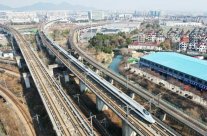
Last Tuesday (May 21), a New Airlines flight from London, UK to Singapore suffered a severe airflow on the way, causing a passenger to die unfortunately and many people injured.On Sunday just passed, a flight from Qatar Airways to Daha to Dublin, Ireland also encountered a strong air flow, causing 12 people to be injured.
A weekly encountering a strong airflow during a week caused a strong airflow during flight. It is believed that air passengers shuddered without chilling, and people's fear of many flights increased by one.According to a study by the National Transport Safety Commission in 2021, airflow -related aviation accidents are the most common. From 2009 to 2018, more than one -third of the accidents are related to airflow.Most of these accidents caused severe injuries of one or more people, but did not cause damage to the aircraft.
U.S. Minister of Communications Budiggg said in a TV show on Sunday that one of the guides that the plane encountered more atmospheric flow was climate change.Climate change leads to many unusual phenomena, such as the heat wave that should not occur in the northwest of the United States, and now the cables that may cause the cable of the bus system;Severe floods were paralyzed by Dubai.
Hurricanes and typhoons are becoming more frequent and extreme, which will inevitably lead to increasing atmosphere.The chaos in thunderstorms can be found through visual or radar, but the Clear Air Turbulence cannot be observed and forecast, so it is more difficult to avoid.A study last year showed that from 1979 to 2020, the relatively busy clear sky over the North Atlantic Ocean increased by 55%, and scientists believed that this phenomenon was closely related to global warming.The impact of climate change on the atmosphere includes the mode of changing the Jet Streams, increasing the frequency and intensity of the occurrence of clear air flow.
The discussion of climate changes is usually focused on natural ecology, human health, and economic stability.In addition to threatening to the life on the ground, climate change also constitutes a major challenge to the security of aviation travel, and the aviation industry urgently needs to be adjusted and improved.Before humans can effectively reverse the trend of climate deterioration, they can only be expected to develop rapidly in new technology. For example, the development of technologies that can detect all airflow in advance, or improve the design of aircraft, improve the stability and resistance of the aircraft in the chaos and the impact of the impact of the aircraft.The ability to reduce passenger injury.Aircraft manufacturers must bear more responsibilities and actively invest in resources for research and development, rather than repeated scandals related to quality and safety issues.
Airlines must also adjust the operating process to deal with extreme climate. For example, Singapore Airlines announced on Thursday that when the seat belt indicator light is on, all meal services will be suspended, and cabin flight attendants must also return to the seat and tie the seat belt.Airlines allow crew members to receive stricter training and better cope with emergencies.Earlier this year, Japanese airlines fired due to collisions when they landed at Haneda Airport. The entire aircraft was devoured by flames. However, 367 passengers and 12 crew members of the aircraft did not seriously casualties. Many people called miracles.That's because the crew of the flight attendant has received strict training factions.The response of the new aircraft crew in this severe airflow incident was also praised. First, the pilot decided to emergency landing in Bangkok instead of Yangon, which was closer. After all, the former's medical facilities were relatively complete.In addition, passengers also praised the passenger's situation of the cabin flight attendants.
Raising the public's awareness of aviation safety can effectively reduce the damage caused by airflow incidents.As passengers, we can take some simple but effective measures to protect ourselves, including developing the habit of tied a seat belt after sitting down, and follow the regulations of the airline when the situation occurs, and obey the instructions of the crew.
Studies have shown that the incidence of clear air flow in the next few years may increase by 150%, and aviation travel will face more risks.Human beings take more measures to reduce greenhouse gas emissions and promote sustainable development, which is the key to fundamentally responding to climate change challenges.Human beings now have one more reason to pay attention to and love our environment: to fly more safely.




